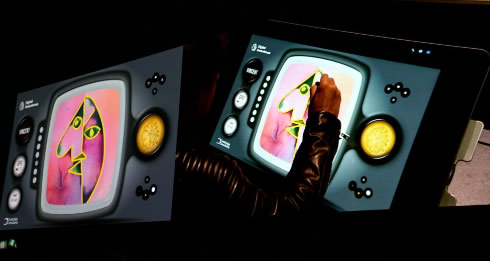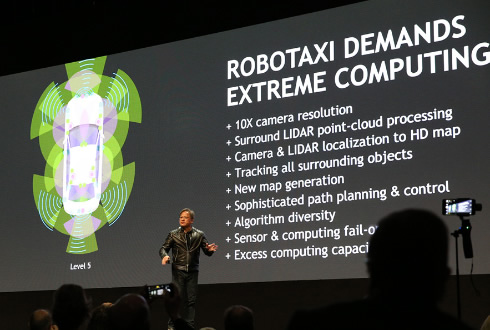
NVIDIA CEO Revs Up Auto Industry with NVIDIA DRIVE PX Pegasus Autonomous Car Computer and Holodeck VR Design Tool
NVIDIA founder and CEO Jensen Huang took the stage Tuesday the GPU Technology Conference in Munich to introduce a new AI computer for fully autonomous vehicles and a new VR application for those who design them.
"GPU computing is the topic of this conference, and we've dedicated our company's life to advancing this form of computing to enable breakthroughs and science all over the world," said Huang, clad in his trademark leather jacket.
Huang described some of the GPU-accelerated applications in computer graphics, scientific computing, machine learning and data science. They've been adopted by industries as diverse as high-performance computing, internet services, automotive, medical imaging, and logistics.
Following the introduction at GTC in May of NVIDIA's new Holodeck VR design application, Huang announced early access to Holodeck, the company's intelligent VR platform.
Holodeck allows designers, developers and their customers together from anywhere in the world to discover, build and explore creations in a highly realistic, collaborative and physically simulated VR environment, Huang said.

In a demo, he showed how a team can beam into a highly realistic virtual environment to explore the design of a dazzling McLaren sports car.
NVIDIA has started accepting applications for Holodeck early access. With early access 3D designers can import models from 3dsMax and Maya into Holodeck. They will need a powerful VR-enabled system to get the best experience from Holodeck. Early access will support GeForce GTX 1080 Ti, Quadro P6000 and TITAN Xp GPUs.
Huang also showed a demo - dubbed "Vincent" - from Cambridge Consultants, which trained a neural network on NVIDIA DGX AI supercomputers to turn quick sketches into drawings in the style of a master artist in real time.

With a few strokes of a stylus, a member of the team at Cambridge Consultants was able to draw a stunning landscape. Intrigued, Huang climbed down from the stage to pick up the stylus to sketch a few lines.
In a moment, a stylized profile of a man in the style of Pablo Picasso seemed to snap into focus.
Huang also unveiled a new member of our DRIVE PX family of autonomous vehicle systems. Codenamed Pegasus, it's designed to enable Level 5 driverless vehicles - such as robotaxis that can operate without any human intervention - to go into production.
That's a demanding task, Huang explained. The computational requirements of robotaxis are enormous - perceiving the world through high-resolution, 360-degree surround cameras, radars and lidars, localizing the vehicle within centimeter accuracy, tracking vehicles and people around the car, and planning a safe and comfortable path to the destination.
The computing demands of driverless vehicles are easily 50 to 100 times more intensive than the most advanced cars today.

NVIDIA's new DRIVE PX Pegasus AI computer - roughly the size of a license plate - can replace the entire trunk full of computing equipment used in today's Level 5 autonomous prototypes. Delivering 320 trillion operations per second of computing power, DRIVE PX Pegasus has the AI performance of a 100-server data center, Huang explained.

NVIDIA DRIVE PX Pegasus is powered by four high-performance AI processors. It couples two of NVIDIA's newest Xavier system-on-a-chip processors -- featuring an embedded GPU based on the NVIDIA Volta architecture -- with two next-generation discrete GPUs with hardware created for accelerating deep learning and computer vision algorithms.
| DRIVE PX Pegasus | |
| SoCs | 2x Xavier |
| Discrete GPUs | 2x Post-Volta |
| CPU Cores | 16x NVIDIA Custom ARM |
| GPU Cores | 2x Xavier Volta iGPU & 2x Post-Volta dGPUs |
| DL TOPS | 320 TOPS |
| TDP | 500W |
Pegasus is designed for ASIL D certification -- the industry's highest safety level -- with automotive inputs/outputs, including CAN (controller area network), Flexray, 16 dedicated high-speed sensor inputs for camera, radar, lidar and ultrasonics, plus multiple 10Gbit Ethernet connectors. Its combined memory bandwidth exceeds 1 terabyte per second.
Pegasus will be available to NVIDIA automotive partners in the second half of 2018. NVIDIA DriveWorks software and NVIDIA DRIVE PX 2 configurations are available today for developers working on autonomous vehicles and algorithms.
Intel and its Mobileye automotive unit are also working with German carmaker BMW and U.S. auto supplier Delphi on their own autonomous driving platform due out in 2021. NXP has agreed to be acquired by Qualcomm to form the world's largest auto electronics supplier, while Bosch, the industry's top auto supplier, is working with carmaker Daimler
For its current generation Drive PX2, NVIDIA has said it has 225 customers, including car and truck makers, Tier 1 auto suppliers, high-definition mapping companies, start-ups and research institutions. These customers can make use of PX2-class software when they upgrade to Pegasus chips, NVIDIA said.
These could encompass existing customers Tesla, including its latest Model 3. Others include Volkswagen's Audi A8, the first car to use Level 3 semi-autonomous driving features, Toyota Motor's next-generation autonomous cars and Geely's Volvo business.
Huang also announced NVIDIA will release a software development kit - NVIDIA DRIVE IX, which stands for intelligent experience - for the company's AI co-pilot technologies.
DRIVE IX enables AI to understand sensor data from cameras and microphones inside and outside the car to enable new capabilities, such as facial identification to unlock the car, gaze-tracking to monitor driver distraction and drowsiness, among others.
In other news here at GTC Europe, NVIDIA announced that Deutsche Post DHL, the world's largest mail and logistics company, and ZF, one of the world's largest automotive suppliers, have teamed up to deploy a test fleet of autonomous delivery trucks starting in 2018.
Deutsche Post DHL will outfit its electric light trucks with the ZF ProAI self-driving system, based on NVIDIA DRIVE PX technology, for automating package transportation and delivery, including the "last mile" of deliveries.
Demonstrating how simulation is a vital part of creating autonomous vehicles, Huang showed how our auto team can simulate driving 300,000 miles in five hours by harnessing 8 NVIDIA DGX systems. This "re-sim" system will allow us to virtually drive every paved road in the United States in just two days.

Finally, to bring it all together, Huang showed a demo of Project Isaac, our AI robot simulator, which uses Holodeck to train autonomous machines, teaching a robot to shoot goals with a toy hockey stick.





















